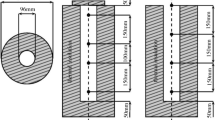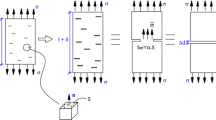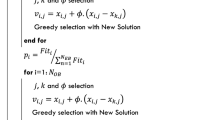Abstract
The kinetics of heat transfer in hardening concrete is a key issue in engineering practice for erecting massive concrete structures. Prediction of the temperature fields in early age concrete should allow for proper control of the construction process to minimize temperature gradients and the peak temperatures, which is of particular importance for concrete durability. The paper presents a method of identification of the thermophysical parameters of early age concrete such as the thermal conductivity, the specific heat, and the heat generated by cement hydration in time. Proper numerical models of transient heat conduction problems were formulated by means of finite-element method, including two types of heat losses. The developed experimental–numerical approach included the transient temperature measurements in an isolated tube device and an in-house implementation of an evolutionary algorithm to solve the parameter identification task. Parametric Bezier curves were proposed to model heat source function, which allowed for identifying such function as a smooth curve utilizing a small number of parameters. Numerical identification tasks were solved for experimental data acquired on hardening concrete mixes differing in the type of cement and type of mineral aggregate, demonstrating the effectiveness of the proposed method (the mean-squared error less than 1 °C). The proposed approach allows for the identification of thermophysical parameters of early age concrete even for mixtures containing non-standard components while omitting drawbacks typical for classical optimization methods.













Similar content being viewed by others
References
Klemczak BA. Modeling thermal-shrinkage stresses in early age massive concrete structures comparative study of basic models. Arch Civ Mech Eng. 2014;14(4):721–33. https://doi.org/10.1016/j.acme.2014.01.002.
Fairbairn EMR, Azenha M, editors. Thermal Cracking of Massive Concrete Structures. State of the Art Report of the RILEM Technical Committee 254-CMS. vol. 27. Springer International Publishing, Cham; 2019. https://doi.org/10.1007/978-3-319-76617-1.
Zhu B. Thermal stresses and temperature control of mass concrete. Elsevier. 2014. https://doi.org/10.1016/C2012-0-06038-3.
Jonasson J-E, Groth P, Hedlund H. Modelling of temperature and moisture field in concrete to study early age movements as a basis for stress analysis. In: International Symposium Thermal Cracking in Concrete at Early Ages, Munich: RILEM; 1994, pp 45–52.
Lawrence AM, Tia M, Ferraro CC, Bergin M. Effect of early age strength on cracking in mass concrete containing different supplementary cementitious materials: experimental and finite-element investigation. J Mater Civ Eng. 2012;24:362–72. https://doi.org/10.1061/(ASCE)MT.1943-5533.0000389.
Nagy A. Simulation of thermal stress in reinforced concrete at early ages with a simplified model. Mater Struct. 1997;30:167–73. https://doi.org/10.1007/BF02486389.
Tasri A, Susilawati A. Effect of cooling water temperature and space between cooling pipes of post-cooling system on temperature and thermal stress in mass concrete. J Build Eng. 2019;24:100731.
Riding KA, Poole JL, Schindler AK, Juenger MCG, Folliard KJ. Evaluation of temperature prediction methods for mass concrete members. ACI Mater J. 2006;103:357–65.
Cifuentes H, Montero-Chacón F, Galán J, Cabezas J, la Concha AM-D. A finite element-based methodology for the thermo-mechanical analysis of early age behavior in concrete structures. Int J Concr Struct Mater. 2019;13:41. https://doi.org/10.1186/s40069-019-0353-0.
Evsukoff AG, Fairbairn EMR, Faria ÉF, Silvoso MM, Toledo Filho RD. Modeling adiabatic temperature rise during concrete hydration: a data mining approach. Comput Struct. 2006;84:2351–62. https://doi.org/10.1016/j.compstruc.2006.08.049.
Sciumè G, Schrefler BA, Pesavento F. Thermo-Hygro-Chemo-Mechanical Modelling of the Behavior of a Massive Beam with Restrained Shrinkage. In: CONCRACK 3—RILEM-JCI International Workshop on Crack Control of Mass Concrete and Related Issues Concerning Early-Age of Concrete Structures 15–16 March 2012, Paris, France: 2012, pp 133–44.
Bentz DP. A review of early-age properties of cement-based materials. Cem Concr Res. 2008;38:196–204. https://doi.org/10.1016/j.cemconres.2007.09.005.
Honorio T, Bary B, Benboudjema F. Thermal properties of cement-based materials: multiscale estimations at early-age. Cement Concr Compos. 2018;87:205–19. https://doi.org/10.1016/j.cemconcomp.2018.01.003.
Phillips SW, Aquino W, Chirdon WM. Simultaneous inverse identification of transient thermal properties and heat sources using sparse sensor information. J Eng Mech. 2007;133:1341–51.
Fairbairn EMR, Silvoso MM, Ribeiro FLB, Toledo-Filho RD. Determining the adiabatic temperature rise of concrete by inverse analysis: case study of a spillway gate pier. Eur J Environ Civ Eng. 2017;21:272–88. https://doi.org/10.1080/19648189.2015.1112843.
Knor G, Glinicki MA, Holnicki-Szulc J. Determination of thermal parameters of hardening concrete by means of inverse problem solution. Roads Bridges-Drogi i Mosty. 2012;11:281–94. https://doi.org/10.7409/rabdim.012.002.
Knor G, Jaskulski R, Glinicki MA, Holnicki-Szulc J. Numerical identification of the thermal properties of early age concrete using inverse heat transfer problem. Heat Mass Transf. 2019;55:1215–27. https://doi.org/10.1007/s00231-018-2504-2.
Zreiki J, Bouchelaghem F, Chaouche M. Early-age behaviour of concrete in massive structures, experimentation and modelling. Nucl Eng Des. 2010;240:2643–54. https://doi.org/10.1016/j.nucengdes.2010.07.010.
Ballim Y. A numerical model and associated calorimeter for predicting temperature profiles in mass concrete. Cement Concr Compos. 2004;26:695–703. https://doi.org/10.1016/S0958-9465(03)00093-3.
Šavija B, Schlangen E. Use of phase change materials (PCMs) to mitigate early age thermal cracking in concrete: theoretical considerations. Constr Build Mater. 2016;126:332–44. https://doi.org/10.1016/j.conbuildmat.2016.09.046.
da Silva WRL, Šmilauer V, Štemberk P. Upscaling semi-adiabatic measurements for simulating temperature evolution of mass concrete structures. Mater Struct Mater Construct. 2015;48:1031–41. https://doi.org/10.1617/s11527-013-0213-3.
Bocciarelli M, Ranzi G. An inverse analysis approach for the identification of the hygro-thermo-chemical model parameters of concrete. Int J Mech Sci. 2018;138–139:368–82. https://doi.org/10.1016/j.ijmecsci.2018.01.035.
Czél B, Gróf G. Simultaneous identification of temperature-dependent thermal properties via enhanced genetic algorithm. Int J Thermophys. 2012;33:1023–41. https://doi.org/10.1007/s10765-012-1226-9.
Bentz D, Waller V, de Larrard F. Prediction of adiabatic temperature rise in conventional and high-performance concretes using a 3-D microstructural model. Cem Concr Res. 1998;28:285–97. https://doi.org/10.1016/S0008-8846(97)00264-0.
Cervera M, Faria R, Oliver J, Prato T. Numerical modelling of concrete curing, regarding hydration and temperature phenomena. Comput Struct. 2002;80:1511–21. https://doi.org/10.1016/S0045-7949(02)00104-9.
Han Y, Fu S, Wang S, Xie Z. Study on adiabatic temperature rise reflecting hydration degree of concrete. Adv Mater Sci Eng. 2018;2018:1–12. https://doi.org/10.1155/2018/1435049.
Czél B, Gróf G. Inverse identification of temperature-dependent thermal conductivity via genetic algorithm with cost function-based rearrangement of genes. Int J Heat Mass Transf. 2012;55:4254–63. https://doi.org/10.1016/j.ijheatmasstransfer.2012.03.067.
Wang S, Xu X. Simplified building model for transient thermal performance estimation using GA-based parameter identification. Int J Therm Sci. 2006;45:419–32. https://doi.org/10.1016/j.ijthermalsci.2005.06.009.
Rita M, Fairbairn E, Ribeiro F, Andrade H, Barbosa H. Optimization of mass concrete construction using a twofold parallel genetic algorithm. Appl Sci. 2018;8:399. https://doi.org/10.3390/app8030399.
Ramadan Suleiman A, Nehdi M. Modeling self-healing of concrete using hybrid genetic algorithm-artificial neural network. Materials. 2017;10:135. https://doi.org/10.3390/ma10020135.
Goldberg DE. Genetic algorithms in search, optimization and machine. Learning. 1989. https://doi.org/10.5860/CHOICE.27-0936.
Michalewicz Z, Fogel DB. How to Solve It: Modern Heuristics. Berlin, Heidelberg: Springer Berlin Heidelberg; 2004. https://doi.org/10.1007/978-3-662-07807-5
Knor G, Glinicki MA, Holnicki-Szulc J, Ossowski A, Ranachowski Z. Influence of calcerous fly ash on concrete temperature during the first 72 h of hardening in massive elements. Roads Bridges-Drogi i Mosty. 2013;12:113–26. https://doi.org/10.7409/rabdim.013.009.
Guo Z, Shi X. Experiment and calculation of reinforced concrete at elevated temperatures. Butterworth-Heinemann. 2011. https://doi.org/10.1016/B978-0-12-386962-3.10005-1.
Piegl L, Tiller W. The NURBS Book. Springer Berlin Heidelberg, Berlin, Heidelberg. 1995. https://doi.org/10.1007/978-3-642-97385-7.
Bäck T. Evolutionary algorithms in theory and practice: evolution strategies, evolutionary programming, genetic algorithms. New York: Oxford University Press; 1996.
Burczynski T, Kuś W, Beluch W, Długosz A, Poteralski A, Szczepanik M. Intelligent computing in optimal design, solid mechanics and its applications, series volume 261. Springer Int Publ. 2020. https://doi.org/10.1007/978-3-030-34161-9.
MSC.MARC. Theory and user information, vol. A-D. MSC Software Corporation; 2017.
Michalewicz Z. Genetic Algorithms + Data Structures = Evolution Programs. Springer Berlin Heidelberg, Berlin, Heidelberg. 1996. https://doi.org/10.1007/978-3-662-03315-9.
Bamonte P, Gambarova PG. Properties of concrete required in nuclear power plants. In: Infrastructure systems for nuclear energy, NY USA. Chichester: Wiley; 2014. p. 409–38.
Glinicki MA, Jaskulski R, Dąbrowski M, Ranachowski Z. Determination of Thermal Properties of Hardening Concrete for Massive Nuclear Shielding Structures. In: Ghafoori N, Claisse PA, Ganjian E (eds) Proceedings of the Fourth International Conference on Sustainable Construction Materials and Technologies, vol. III, Las Vegas, USA: Coventry University; 2016, p. 1455–62. http://www.claisse.info/2016%20papers/D152.pdf
Kurtis KE, Xi Y, Glinicki MA, Provis J, Giannini ER, Fu T. Can we design concrete to survive nuclear environments? Concr Int. 2017;39:29–35.
Baran T, Glinicki MA, Jóźwiak-Niedźwiedzka D. The properties of special cements for shielding constructions in nuclear power plants. Cement Wapno Beton. 2016;21:207–16.
Klemczak B, Batog M, Giergiczny Z, Żmij A. Complex effect of concrete composition on the thermo-mechanical behaviour of mass concrete. Materials. 2018;11:1–18. https://doi.org/10.3390/ma11112207.
Jóźwiak-Niedźwiedzka D, Gibas K, Glinicki MA. Petrographic identification of reactive minerals in domestic aggregates and their classification according to RILEM and ASTM recommendations. Roads Bridges-Drogi i Mosty. 2017;16:223–39. https://doi.org/10.7409/rabdim.017.015.
Jaskulski R, Glinicki MA, Kubissa W, Dąbrowski M. Application of a non-stationary method in determination of the thermal properties of radiation shielding concrete with heavy and hydrous aggregate. Int J Heat Mass Transf. 2019;130:882–92. https://doi.org/10.1016/j.ijheatmasstransfer.2018.07.050.
Długosz A, Pokorska I, Glinicki MA, Jaskulski R. Identification of thermal properties of hardening concrete by means of evolutionary algorithms. Comput Assist Methods Eng Sci. 2017;24:101–11.
Funding
This study is funded by National Center for Research and Development (Grant Nos. PBSII/A2/15/2014 and V4-Korea/2/2018) and Politechnika Śląska (10/040/BK_20/0094).
Author information
Authors and Affiliations
Corresponding author
Additional information
Publisher's Note
Springer Nature remains neutral with regard to jurisdictional claims in published maps and institutional affiliations.
Rights and permissions
About this article
Cite this article
Długosz, A., Pokorska, I., Jaskulski, R. et al. Evolutionary identification method for determining thermophysical parameters of hardening concrete. Archiv.Civ.Mech.Eng 21, 35 (2021). https://doi.org/10.1007/s43452-020-00154-7
Received:
Revised:
Accepted:
Published:
DOI: https://doi.org/10.1007/s43452-020-00154-7




